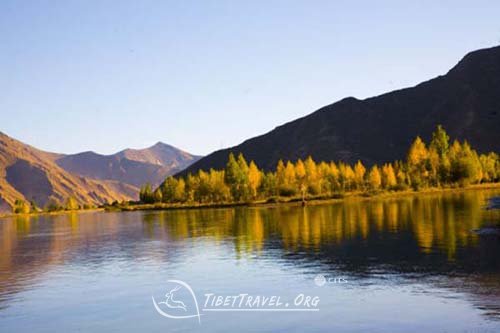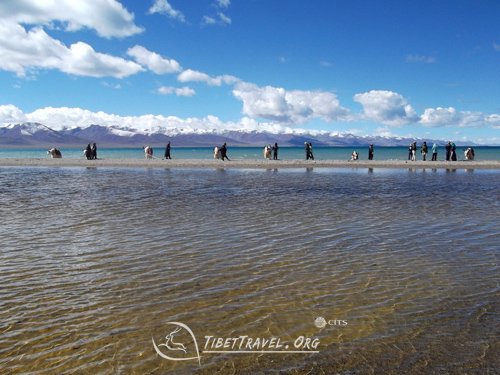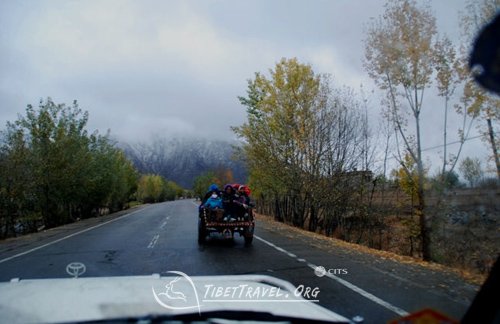I have had a group of 4 clients from Italy planning a trip from Lhasa to Kashgar in June,2011. Lhasa to Kashgar overland tour is considered the most difficult road trip in China, as a big part of the land driving is above 5000m. and the natural condition is extremely rough,even be called no man's land.
The road named Xingjiang Tibet Highway, national road 219 (G219), runs along the southwestern border of the China, starting from Yecheng in the Xinjiang and ending in Lhasa, It is 1,296 miles (2,086 kilometers) in length. Tourists need to arrange a two weeks journey from Lhasa or from Yecheng, including visiting the sightseeing spots on the way. let me advice something about how to arrange the trip.
First of all, I highlights some important tourist attractions on the way you may take it into consider if you would like to pay a visit for them.
1) Shigatse and Gyantse
If starting the trip in Lhasa, the first two tourist cities is Gyantse and Shigatse, if travel to Gyantse, you need make a detour to Yamdrotso Lake, Karola Gleirs, and Gyantse city, which makes 1 day tour longer and 100km driving longer than driving directly from Lhasa to Shigatse. but the 1 more day tour is worthwhile.
2) Mt. Everest
First section of your road is from Lhasa to Lhatse, Lhatse is a small town of a few thousand people in Tibet, in the valley of the Yarlung Tsangpo River (aka Brahmaputra) in Lhatse County, 151 km southwest of Shigatse and just west of the mountain pass leading to it. Lhatse is 4,050 m. The main road from Lhasa devided into two roads, one is to Everest Base Camp and the other is to Kashgar. At this point, you need to make a decition if you pay a visit to Everest Base Camp in Tibet, it takes you 6 hours and 188km driving. you need to arrange 2 more days for tour to Everest Base Camp.
2) Mt. Kailash Kora
Mount Kailash Kora is a trekking around Mt. Kailash. Kailash trek is one of the most demanding and challenging of treks for pilgrims in the world. Pilgrims throng to the mountain: not just Tibetans, but Hindus and Buddhists from India to Japan, joined by Western and Chinese travelers who travel to Tibet to visit this holy mountain, most foreigners take two to three days for the trekking.
3) Guge Kingdom
Ruins of Guge Kingdom are the Old Palace of Tibet. it was stablished in about the 10th century, and founded by Guge Kingdom. There were about 16 kings with armies of tens of thousands of soldiers during the over 700 years during its flourishing time. if you want to pay a visit to this Ruins, you need arrange one or two days into your long trip.
I guided Kailash Tour very often, almost more than 10 times a year since I have been a tour guide working for Tibet Travel Org.
As it is a quite a long trip, the cost is awaresome, you have to take it into consider and prepare enough money to cover all the cost along the trip.
Cost One: Getting into Tibet
You need to consider the cost for getting into Tibet:
By air from Beijing to Tibet or Shanghai to Tibet, it takes about 400-500 USD per person for a 4 hours flying.
By train to Lhasa from any starting city in China Mainland, takes you 45 to 56 hours, 2 days and 2 nights. price is from 100USD to 250USD, depends on the tickets grade you choose.
For organizing the overland trip from Lhasa to kashgar.
I believe everybody has fully realized that this is a long journey and the land cruiser will need drive for more than 3000km for one way, the living conditions after 2 to 3 days you leave Lhasa is quite poor. That means the services Tibet travel agency is able to give you are poor too; no need to reserve hotels in remote area, no need to specify the restaurants, etc. I suggest, you requires "permit + tour guide + 4WD rental" package, the more service you required the more service charge you need pay to tour operator. the hostels, food, admission fee of tourist attractions you can arrange it on your own on site. do not need worry about hotel booking, there is no need to reserve hotels along this poor way. some hostels has no contact at all.
Then you make sure what the trip is, and how to plan this trip. I believe you can start to prepare the itinerary, contact our agency Tibet Travel Org to offer you a wonderful and affordable trip in Tibet.















